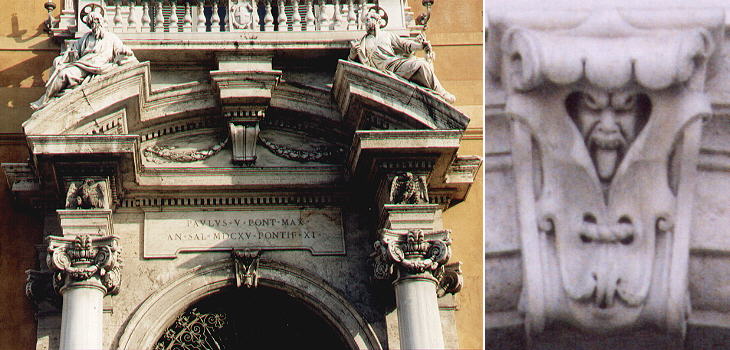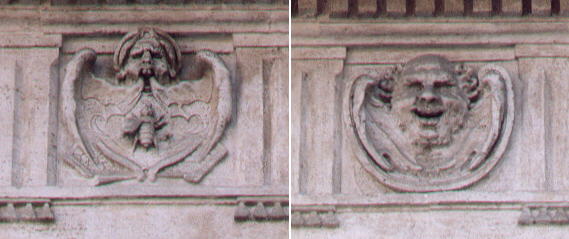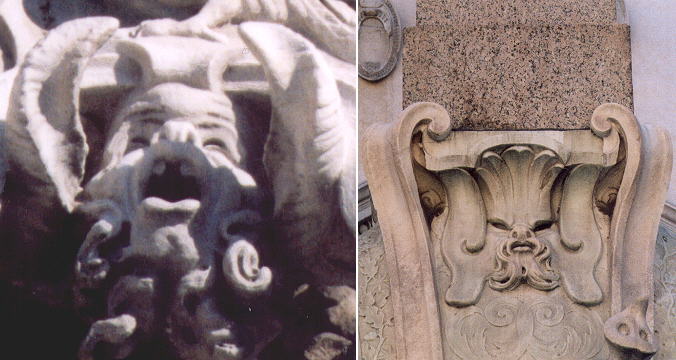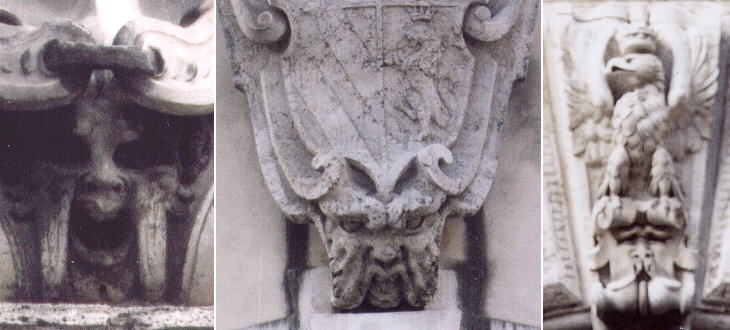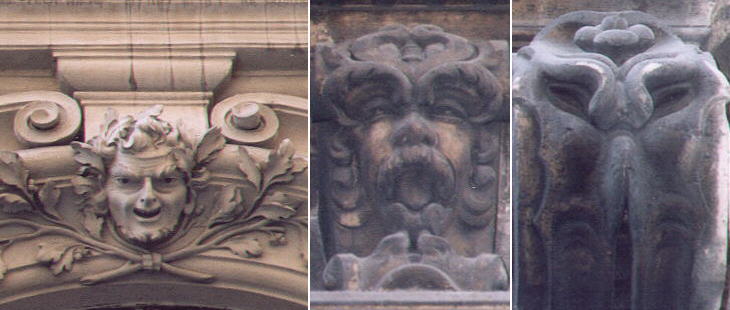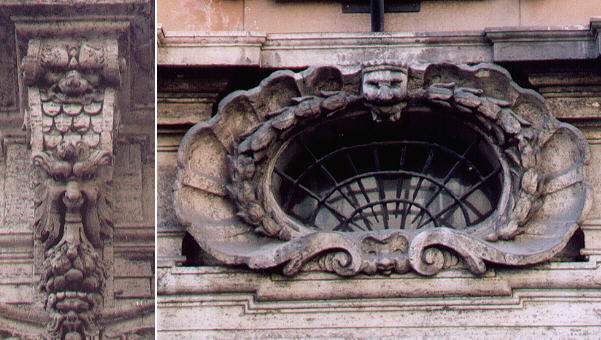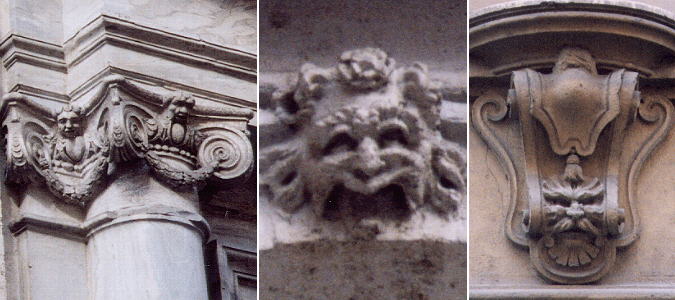

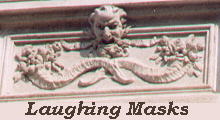 Laughing Masks Laughing Masks
(a laughing mask in Fontana di Trevi)
Palazzo del Quirinale was initially built towards the end of the XVIth century as a summer
residence for the popes, replacing in this function Palazzo Venezia. The new residence, while being, similarly to Palazzo Venezia,
at a certain distance from the river to minimize the risk of contracting malaria, because of its position on the hill enjoyed to a greater extent the breeze which at sunset
tempers the heat of the Roman summer days.
Enlarged and embellished by several popes, with Clemens XII (1730-40) the palace became the official
residence of the pope. The palace was sacked by the French troops in February 1798: according to the chronicles even the doors were taken away: the French occupied the palace a
second time in July 1809 when they arrested Pope Pius VII: however it was soon restored by the French administration as Rome, annexed to the French Empire, became its second capital and
the palace became an imperial residence with an apartment for the Roi de Rome (King of Rome), the son of Napoleon born in 1811. The emperor himself was expected
to visit Rome in 1812: he never came to Rome, as he headed instead towards the third Rome, Moscow,
where his star begun its declining course.
Pius VII returned to Palazzo del Quirinale in May
1814 and the palace became even more than in the past the papal residence as the conclaves of 1823, 1829, 1831and 1846 were held there and the announcements of the new pope were made
from its balcony (Loggia delle Benedizioni), designed by Bernini.
When the Italian troops arrived on September 20, 1870, Pope Pius IX, while claiming the
illegitimacy of the Italian occupation, preferred to retire to the Vatican. The Quirinale, as the palace is commonly called, then became the residence of the King of Italy and after 1946 of the President of the Republic.
Every decent Italian sees in the palace a symbol of the Nation and when he/she reaches its entrance, decorated with the eagles of the Borghese, the statues of St. Peter and St. Paul, the cross of the
Savoia royal family and the Italian and European flags, he/she feels compelled to start humming the national anthem, but...
Entrance of Palazzo del Quirinale
... the solemnity of the portal designed in 1615 by Carlo Maderno for Paulus V Borghese is
interrupted by a tiny irreverent mask almost hidden in a little case below the inscription celebrating the completion of the portal itself.
The domes of its churches, the obelisks and the fountains of its squares, the statues of saints, angels and virtues,
the gigantic coats of arms of the popes and the inscriptions celebrating their achievements
all contribute to the grandeur and pomp of Rome. But those same popes and artists who
wanted and designed these monuments included a sort of antidote against their works being taken too seriously: a laughing mask was very often
hidden in works of art designed between 1550 and 1750. The image you see in the background of this page
shows a mask hidden in a fountain designed by Giovanni Vasanzio for Paulus V.
Masks by Gian Lorenzo Bernini in Palazzo Barberini
Bernini decorated Palazzo Barberini with a traditional frieze, but while the triglyphs (maybe you wish to consult my glossary) are designed according to the canons
of classical architecture, the reliefs of some metopes are pretty unusual: they portray masks in different moods in a frame of bat wings: it is difficult to understand
why in a palace
meant to testify to the glory of the Barberini, both the family and Bernini agreed to include these reliefs, but one has to remember that the most celebrated
statue by Bernini Apollo and Dafne is a metaphor of illusion, of the possibility of something not being what we believe it is.
Masks in Fontana dei Quattro Fiumi and Obelisco della Minerva
Bernini often hid masks in the lower part of a coat of arms. The eight coats of arms he
designed for the baldaquin in St. Peter's all have masks in different attitudes. He personally sculptured the
laughing mask of the coat of arms of Innocentius X Pamphilj in Fontana dei Quattro Fiumi in Piazza Navona.
Bernini hid a slightly mysterious mask, maybe an Egyptian prince, in the pedestal he designed for the obelisk in Piazza della Minerva.
Masks hidden in coats of arms of Clemens IX in Banco di S. Spirito, Pius IX in Scuderie Papali, the Borghese family in a palace near Palazzo Borghese
Many other coats of arms show hidden masks: they can be seen not only in the coats of arms designed during the Baroque period, but also in those of the XIXth and XXth centuries.
Masks in Palazzo Capponi Stampa and in nearby Palazzo Cerri
The portal of Palazzo del Quirinale is not the only one to be decorated with a mask. In some cases, rather than being hidden, they constitute the main decoration of the portal. Palazzo Cerri has a very strange mask which portrays a man in the act of
waking up and yawning: in addition to the mask at the center of the portal the folds of the lateral decorations design a threatening face.
One is not enough! Masks in the terrace of Palazzo Borghese and in a building next to S. Bartolomeo dei Bergamaschi
Occasionally one mask was not thought to be enough. Flaminio Ponzio who designed in 1612-14 the side of Palazzo Borghese overlooking the Tiber included three
masks in the corbels supporting the balcony. While the central and the lower masks can
be seen from all viewpoints, the upper one can be noticed only from below.
Masks in S. Giacomo in Augusta, Oratorio del SS. Crocefisso, SS. Celso e Giuliano
Even churches were decorated with masks, although they could hardly be considered a Christian symbol.
The masks are usually ignored in the description of the monuments of Rome, nevertheless they contribute to make more
human a city which has an excess of sanctity and glory.
Other pages dealing with Baroque sculpture:
Statues in the act of praying
Monuments showing the dead in a medallion
Representation of Death in Baroque sculptures
Three busts by Alessandro Algardi
Baroque Angels
Three chapels by Gian Lorenzo Bernini
Baroque Monuments to the Popes
Baroque High Reliefs
Statues Close to Heaven
Embittered Andrew (the statues in St. Peter's octagon)
Playing with Colours
See also my List of Baroque Architects and my Directory of Baroque Sculpture.

Go to my Home
Page on Baroque Rome or to my Home Page on Rome
in the footsteps of an XVIIIth century traveller.
|


 Laughing Masks
Laughing Masks